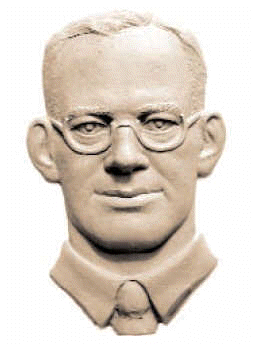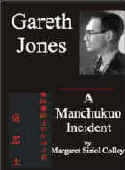Gareth Jones
[bas relief by Oleh Lesiuk]
HOME |
Stop Press |
Complete Soviet Articles & Background Information |
Précis of Gareth's
|
All Published Articles |
BOOKS
|
|
|
|
More Than Grain of Truth(2005) |
|
|
TOPICAL
'Are you Listening NYT?' U.N. Speech - Nov 2009 |
Gareth Recognised at Cambridge - Nov 2009 |
Reporter and the Genocide - Rome, March 2009 |
Order of Freedom Award -Nov 2008 |
Premiere of 'The Living' Documentary Kyiv - Nov 2008 |
Gareth Jones 'Famine' Diaries - Chicago 2008 |
Aberystwyth Memorial Plaque 2006 |
GENERAL
Scholarship Fund |
Site Map |
Links |
Legal Notices |
Sponsored Links |
Contact |
The Times, October 14th 1931
THE REAL RUSSIA
- - -
THE PEASANT ON THE FARM
- - -
1. - INCREASE AND ITS COST
In October 1930, “ The Times“ published a series of articles under the heading “The Two Russia's.”
The same writer, who has just returned from another visit to Russia, now
contributes further impressions of the country, the first of which follows.
From a Correspondent (Gareth Jones)
The cities and towns of Soviet Russia are isolated oases in the vast extent of the Russian countryside. Inhabited by a small minority of the population, they are not the real Russia. Nor do the proletarian Communists who greet the foreign visitor, and impress him with their enthusiasm, represent the masses of that union of races, nations, and tribes which stretches from the borders of Poland for 6,000 miles to the Pacific. The real Russia is to be found in the distant villages never, or rarely, seen by the traveller. The peasant is the central figure of the Soviet Union and must remain so. Not only do the peasants form the overwhelming majority of population, but also it is upon their production of grain that the Soviet regime depends. The peasant problem will always be the most important in Russian affairs.
During the last two years the Russian village has been stirred to its depths.
The Revolution, which in 1917 uprooted the workers, the nobility, and the
middle-class, has at last swept across the Russian plains and transformed the
lives of the peasants as 13 years ago it transformed the lives of
town-dwellers. The Bolshevist Revolution strengthened the feeling for
private property among the peasants, and in 1927 capitalism was more firmly,
entrenched in the villages than it had ever been. The disappearance of
large-scale farming, the splitting up of the land among 26,000,000 small
households and the re-emergence of a kulak class which employed the labour of
others, were a danger to the Communist power. With energy, ruthlessness,
and confidence that it would overcome all obstacles, the Communist Party
launched its policy of collectivization. For two years this policy has
been pursued. How does the peasant react to collectivization? What
methods have been employed in, this unprecedented attack on private property?
How far has it succeeded? How will it affect the industrialization plans
of the ‘Government? The following observations on these questions are
based on unconducted visits to collective farms and to State farms. The
writer, who had no difficulty in travelling wherever he wished and wandered on
foot to whatever farms he pleased, was able to gain the confidence of a large
number of peasants in different parts of Russia. The unanimity of their
views was striking.
HARRYING THE KULAKS
The Stalin kolkhoz (collective farm) was in a district of complete
collectivization. Since 1929, when it had its beginnings in the village,
the kolkhoz had been in the turmoil of class warfare, but now, in the autumn of
l931, all was calm again. The president of the Village Soviet, a keen,
energetic young Communist, before whom the older peasants bowed low and bared
their heads respectfully, explained with pride how they had achieved unity in
the village. “We had 40 kulak families and we sent them all away.
It was not enough to send the men only, because we must pluck up all the kulak
elements by the roots. So we sent the women and children too. They
went to Solovki, or to Siberia to cut wood or to work on the railways. In
six years, if they have shown themselves on our side, they will be allowed to
return. We leave the very old kulaks here, because they are no danger to
the Soviet power. Now the fight against the kulaks has ended in our
victory for the last kulak went a month ago. He was the ringleader of a
religious sect in the village. He collected a number of peasants in his
house and told them in meetings that the Communists wished to starve all the
peasants. He prophesied that war would come and that the Pope that Rome
would visit the village and would hang all the Communists. That was
counter-revolutionary agitation, so now that ringleader is in Siberia doing hard
labour. He is working as hard as those farm labourers he used to hire.”
The 'dekulakization' which the president of the Village Soviet of the Stalin
kolkhoz described has been vigorously pursued throughout the country. As the
steamer on which I travelled was going down the Volga, a hundred peasants, men,
women, and children, with all their goods and chattels, could be seen sitting
motionless on the bank, staring at the river in hopeless despair. A woman
on the boat turned to me and said quietly, “Do you see those? They are
kulaks, being exiled, just because they have worked hard throughout their lives.
The peasants have been sent away in thousands to starve. It is terrible
how they have treated them. They have not been given bread-cards or
anything. A large number were sent to Tashkent and were left bewildered on
the town square. They did not know what to do and very many starved to
death.”
THE GERMAN COLONISTS
The German colonists have suffered equally. The president of a German
collective farm informed that in his village of 600 inhabitants, six families
with women and children had been exiled. In the same village a woman
described how the kulaks had been banished. “ We received letters,”
she added, “telling us that from the German colony of several villages in the
district 90 kulak children had died on the journey to Siberia or on arrival
there. We are afraid of being sent away as kulaks, because they might say
you were a kulak for political or personal reasons. We had a letter from
one of the kulaks saying that they were cutting wood far away in Siberia, that
life was terribly hard and that they did not have enough to eat.”
This fear of being exiled as a kulak has been a powerful factor in drawing into
the collective farms. In the Stalin kolkhoz, upon which I stayed, a
sharp-eyed, dark-haired peasant approached me in the Village Soviet hut in the
presence of the Communist president. He spoke to me of the successes of
the kolkhoz, of the enthusiasm of the country for the collective farm movement,
amid of the affection of the peasants for their young Bolshevist leader.
This last statement was accompanied by a friendly clap on the back of the
president of the Village Soviet. Next morning, however, when far away from
any of the Communist members of the kolkhoz, the same peasant, who to all
appearance was an enthusiastic supporter of the Soviet power, approached me amid
whispered: “It is terrible here in the kolkhoz. We cannot speak or
we shall be sent away to Siberia as they sent the others. We are afraid.
I had three cows. They took them away and now I only get a crust of bread.
It is a thousand times worse now than before the Revolution; 1926 and 1927 were
fine years, but now we dare not oppose the Communists or we shall be exiled.
We have to keep quiet.”
Dissatisfaction
with the treatment of the kulaks has spread to the Red army and to the towns.
A village girl working in Moscow described how her cousins had fared: “The
peasants have been forced to join the collective farms. Take my two
cousins. They worked night and day, day and night. With their own
hands they built fine cottages, and what happened. They refused to join
the kolkhoz and they were sent away to the Urals, where it is very, very bad.
And there is my other cousin. He had two cows, two pigs, and some sheep
and he owned two huts. They called him a kulak and they forced him to
sell all he had. Only 300 roubles did they give for everything – cows
and huts and all. The other peasants in the village were told that if they
did not join the collective farm they would be sent to Archangel, or the Urals
or Siberia. So, of course, they joined. They had trouble with some
peasants. In my village they murdered two Communists.”
In such a way
were the kulaks liquidated and scattered throughout Russia to work in the
forests, in mines, and on the roads. The period of the liquidation of the
kulak has almost ended. The policy of the Communist Party has triumphed
for they have crushed their enemies in the villages and 60 percent of the
peasant households are no members of collective farms. The day of the
individual farmer is over, and pressed by high taxes fearing least his house be
taken away from him or dreading a hungry exile in Siberia, he becomes a member
of a collective farm. He is dazed, his old life is shattered and he does
not know what the future has in store. It would be premature to draw final
conclusions for collective farms are in their infancy; but the reactions of the
peasants can be concisely described. Throughout Russia on hears the same
tale: “They took away our cow. How can it get a better if we have no
land and no cow?” The cry of the Russian peasant has always been “Land
and Liberty”, and it is the same cry today.
ONE COW AND NONE
In many collective farms the peasant is allowed to maintain one cow in his courtyard. In the Stalin collective farm where I stayed, the socialisation had made greater strides, and all cattle, pigs, and sheep had become the property of the community. The dvor (farmyard) was empty, and this was tragically strange to the peasant who from his birth had been accustomed to his animals in the farmyard. “Our dvor is empty,” says the peasant sadly, and he cannot reconcile himself to the ghostly silence behind his hut. He bewails also the lack of food and clothing on the farms. On the Stalin farmwomen receive ten pounds of black bread a month and cabbage soup, while those who remain at home receive nothing at all. In the Ukraine, in one collective the ration was 20 lb. The peasants complain: “Come and see the grain, rotten grain: that is what they keep for us. All the best grain is sent to the nearest town for export, and we do not get enough to eat. Poor Mother Russia is in a sorry plight. What we want is land and our own cows.” In some villages the government seizure of grain has lead ton fighting between the peasants and the Communist authorities.
To the
peasant accustomed to till his own strips of land and milk his own cow whenever
he wishes, the system is irksome. The collective farm is divided into a
number of brigades, each commanded by a brigadier, who in general is young
Communist. The kolkhoz administration decides how many worker shall take
part in the threshing, how many in the ploughing, or how many in the milking.
One peasant expressed his feelings towards the system in the following words:
“It is like being in the army when one is sent out with the brigade.”
PIECEWORK
The
brigadier has the task of deciding how much work each peasant has carried out,
for much stress is now being laid upon piecework in the villages. Equal
pay proved a disastrous failure in the collective farms, for there is no
incentive to work, and there was difficulty in persuading the less conscientious
peasants to go out in the fields. Since piecework was introduced the work
has been more satisfactory. Each collective farm worker has a book in
which the brigadier inscribes each day the amount of work he has done.
Upon this book is printed the following rule from the Sixth Congress of the
Soviets held in March: “He who works most and best shall receive the most; he
who does not work at all shall receive nothing; this should be the rule for all
collective farm members and collective farms.” Each collective member
has his task to perform. If he carries out the task his day’s work
counts as one working day. If he exceeds the task by 20%, then his day is
1.20 working day; if he only s ploughs half the average set, his work for the
day is inscribed in his book as 0.50 working day. At the end of the year the
amount of work he has performed is reckoned and the profits of the collective
farm are shared among the members according to the number of days the have shown
in their books. Throughout the year the peasant receives a monthly
advance. This piecework system, while imprisoning the worker in the
shackles of bureaucracy, leads to better work than the system of equal pay.
It demands, however, good accountants, who are not numerous in Russia.
Among the poorer peasants the kolkhoz movement has
keen supporters. In one collective farm one old white-haired man bowed
deeply and groaned: “Have pity on me! My courtyard is empty. Three
horses and three cows have they taken from me and now they are getting thin and
scraggy because they are not well kept. How can I get enough to eat? It is
a dogs life.” A woman was passing and stopped to shriek at him.
“Its little pity you deserve! You had your horses. You had your
cows and you had little pity for us poor peasants then. I had no cow and
no horse. I am better off under the kolkhoz.”
MODERN METHODS
To what
extent the happiness of the peasant may be affected, there is no doubt that
production will increase. The old methods of tilling the land in Russia
are giving way to the modern methods of science. The introduction of
machinery, although the tractors may now be wrecked and left out in all weathers
will in time lead to more grain and this would have been impossible without the
ruthless suppression of the strip system. The influence of this upon the
regime is inestimable. In the future the peasant will not be able to
menace the towns without withholding his grain, for Communist control over the
collective farms is supreme and whereas until two or three years ago the task of
the authorities in the collecting of grain as a formidable one, it is now
simplified by the concentration of the grain into collective farm stock.
Having won the battle against the peasant, the Soviet regime finds itself in a
stronger position than it has ever been before, and assured of a stable supply
of bread for the towns, for the Red Army or the G.P.U, it is able to devote its
energies to its plan of industrialisation.
|
|
|
|



